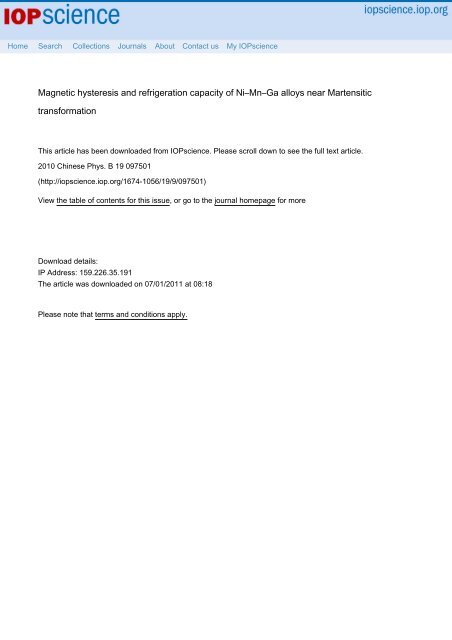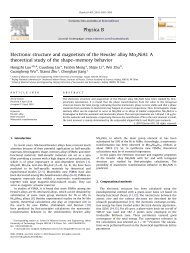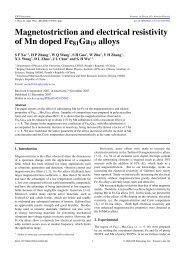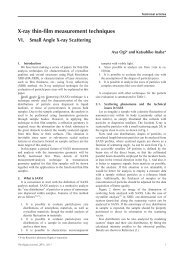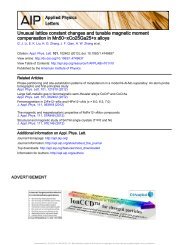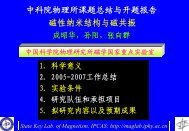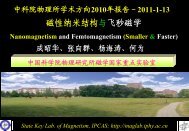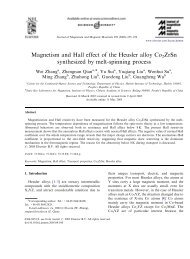Magnetic hysteresis and refrigeration capacity of NiâMnâGa alloys ...
Magnetic hysteresis and refrigeration capacity of NiâMnâGa alloys ...
Magnetic hysteresis and refrigeration capacity of NiâMnâGa alloys ...
- No tags were found...
Create successful ePaper yourself
Turn your PDF publications into a flip-book with our unique Google optimized e-Paper software.
Home Search Collections Journals About Contact us My IOPscience<strong>Magnetic</strong> <strong>hysteresis</strong> <strong>and</strong> <strong>refrigeration</strong> <strong>capacity</strong> <strong>of</strong> Ni–Mn–Ga <strong>alloys</strong> near MartensitictransformationThis article has been downloaded from IOPscience. Please scroll down to see the full text article.2010 Chinese Phys. B 19 097501(http://iopscience.iop.org/1674-1056/19/9/097501)View the table <strong>of</strong> contents for this issue, or go to the journal homepage for moreDownload details:IP Address: 159.226.35.191The article was downloaded on 07/01/2011 at 08:18Please note that terms <strong>and</strong> conditions apply.
Chin. Phys. B Vol. 19, No. 9 (2010) 097501<strong>hysteresis</strong> between heating <strong>and</strong> cooling is due to thedifferent processes between the positive <strong>and</strong> reversemartensite-austenite transition. The twin boundarymotion may be the cause <strong>of</strong> larger magnetic <strong>hysteresis</strong>during cooling. [17,18] So, much attention should bepaid to the cooling isothermal magnetisation processin the research <strong>of</strong> Ni–Mn–Ga <strong>alloys</strong> when it is used asthe magnetic refrigerators in <strong>refrigeration</strong> cycle.Fig. 2. Isothermal magnetisation curves <strong>of</strong> Ni 54.7 Mn 20.1 Ga 25.2 alloy in heating (a) <strong>and</strong> cooling (b) processes.Fig. 3. Isothermal magnetisation curves <strong>of</strong> Ni 53.75 Mn 19.5 Cu 1.75 Ga 25 alloy in heating (a) <strong>and</strong> cooling (b) processes.Fig. 4. Isothermal magnetisation curves <strong>of</strong> Ni 55.2 Mn 18.6 Ga 26.15 Gd 0.05 alloy in heating(a) <strong>and</strong> cooling(b) processes.The numerical integration <strong>of</strong> the area under the −∆S M (T ) curve between T 1 <strong>and</strong> T 2 leads to the cooling<strong>capacity</strong> q = − ∫ T 2T 1∆S M (T )dT . The way to take into account the <strong>hysteresis</strong> loss is to simply subtract it fromthe corresponding q <strong>and</strong> obtain the net <strong>refrigeration</strong> <strong>capacity</strong> q N . The values <strong>of</strong> q N <strong>of</strong> all three <strong>alloys</strong> werecalculated <strong>and</strong> shown in Table 1.097501-3
Chin. Phys. B Vol. 19, No. 9 (2010) 097501The results in Table 1 indicate that large ∆S M does not mean large magnetic <strong>refrigeration</strong> <strong>capacity</strong>. Because<strong>of</strong> the existence <strong>of</strong> the magnetic <strong>hysteresis</strong>, the relation between the magnetic entropy change <strong>and</strong> <strong>refrigeration</strong><strong>capacity</strong> is not simply linear. All <strong>of</strong> the <strong>alloys</strong> show larger q N during heating. From the viewpoint <strong>of</strong> practicalapplication, it is <strong>of</strong> fundamental importance that <strong>hysteresis</strong> should be reduced as much as possible.<strong>alloys</strong>Table 1. The ∆S M , q <strong>and</strong> q N <strong>of</strong> Ni 54.7 Mn 20.2 Ga 25.1 , Ni 53.75 Mn 19.5 Cu 1.75 Ga 25 ,<strong>and</strong> Ni 55.2 Mn 18.6 Ga 25.15 Gd 0.05 <strong>alloys</strong>.|∆S M |/(J/kg K) q/(J/kg) q N /(J/kg)heating cooling heating cooling heating coolingNi 54.7 Mn 20.2 Ga 25.1 8.8 12.7 68.8 57.5 59.5 52.7Ni 53.75 Mn 19.5 Cu 1.75 Ga 25 22.5 16.3 60.5 61.1 66.1 45.2Ni 55.2 Mn 18.6 Ga 25.15 Gd 0.05 7.7 8.6 55.7 51.1 54.5 27.14. ConclusionsThe present work indicates that Ni–Mn–Ga <strong>alloys</strong> show larger magnetic <strong>hysteresis</strong> when they transform fromaustenite to martensite during cooling, but smaller magnetic <strong>hysteresis</strong> when they transform from martensiteto austenite during heating. From this cause, <strong>hysteresis</strong> loss leads to larger q N <strong>and</strong> smaller q N during heating<strong>and</strong> cooling processes in Ni–Mn–Ga <strong>alloys</strong>, respectively. Therefore, the MCE <strong>of</strong> Ni–Mn–Ga <strong>alloys</strong> shouldbe investigated on both cooling <strong>and</strong> heating if Ni–Mn–Ga <strong>alloys</strong> are considered to be used in the magnetic<strong>refrigeration</strong> technology.References[1] Cherechukin A A, Takagi T, Matsumoto M <strong>and</strong>Buchel’nikov V D 2004 Phys. Lett. A 326 146[2] Zhou X Z, Li W, Kunkel H P, Williams G <strong>and</strong> Zhang S H2005 J. Appl. Phys. 97 10M515[3] Pasquale M, Sasso C P, Lewis L H, Giudici L, Lograsso T<strong>and</strong> Schlagel D 2005 Phys. Rev. B 72 094435[4] Stadler S, Khan M, Mitchell J, Ali N, Gomes A M,Dubenko I, Takeuchi A Y <strong>and</strong> Guimarães A P 2006 Appl.Phys. Lett. 88 192511[5] Long Y, Zhang Z Y, Wen D, Wu G H, Ye R C, Chang YQ <strong>and</strong> Wan F R 2005 J. Appl. Phys. 98 046102[6] Duan J F, Huang P, Zhang H, Long Y, Wu G H, Ye R C,Chang Y Q <strong>and</strong> Wan F R 2007 J. Alloys Compd. 432 45[7] Krenke T, Duman E, Acet M, Moya X, Manosa L <strong>and</strong>Planes A 2007 J. Appl. Phys. 102 033903[8] Bhobe P A, Priolkar K R <strong>and</strong> Nigam A K 2007 Appl.Phys. Lett. 91 242503[9] Han Z D, Wang D H, Zhang C L, Tang S L, Gu B X <strong>and</strong>Du Y W 2007 Appl. Phys. Lett. 89 182507[10] Khan M, Ali N <strong>and</strong> Stadler S 2007 J. Appl. Phys. 101053919[11] Zhang X X, Zhang B, Yu S Y, Liu Z H, Xu W J, Liu GD, Chen J L, Cao Z X <strong>and</strong> Wu G H 2007 Phys. Rev. B76 132403[12] Provenzano V, Shaplro A J <strong>and</strong> Shull R D 2004 Nature429 853[13] Shen J, Gao B, Zhang H W, Hu F X, Li Y X, Sun J R<strong>and</strong> Shen B G 2007 Appl. Phys. Lett. 91 142504[14] Shen J, Li Y X, Sun J R <strong>and</strong> Shen B G 2009 Chin. Phys.B 18 2058[15] Duan J F, Huang P, Zhang H, Long Y, Wu G H, Ye R C,Chang Y Q <strong>and</strong> Wan F R 2007 J. Alloys Compd. 441 29[16] Duan J F, Long Y, Bao B, Zhang H, Ye R C, Chang Y Q,Wan F R <strong>and</strong> Wu G H 2008 J. Appl. Phys. 103 063911[17] Han M, Bennett J C, Gharghouri M A, Chen J, HyattC V <strong>and</strong> Mailman N 2008 Materials Characterization 58764[18] Likhachev A A <strong>and</strong> Ullakko K 2000 Phys. Lett. A 275 142097501-4


